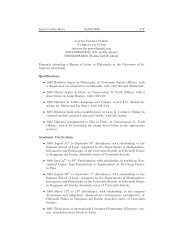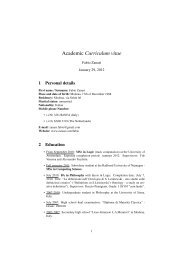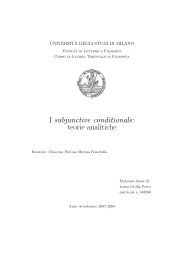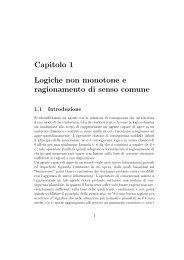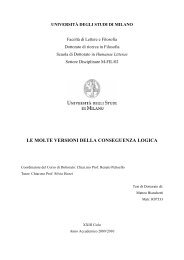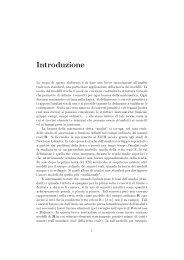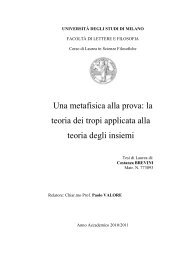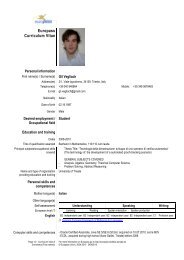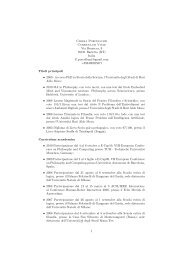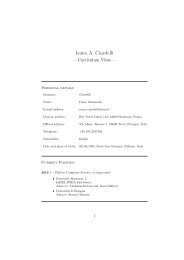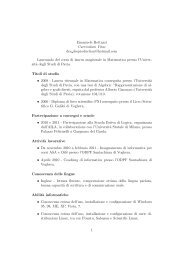Ω-Theory: Mathematics with Infinite and Infinitesimal Numbers - SELP
Ω-Theory: Mathematics with Infinite and Infinitesimal Numbers - SELP
Ω-Theory: Mathematics with Infinite and Infinitesimal Numbers - SELP
Create successful ePaper yourself
Turn your PDF publications into a flip-book with our unique Google optimized e-Paper software.
CHAPTER 1. Ω-CALCULUS<br />
The two operations F ↦→ mF <strong>and</strong> m ↦→ Fm are one the inverse of the other, <strong>and</strong><br />
in this corrispondence the principal (resp. non principal) ultrafilters corresponds to<br />
the principal (resp. non principal) maximal ideals.<br />
We are interested in ultrafilters that are in correspondence <strong>with</strong> maximal ideals<br />
m ⊃ i0. We explicitely observe that those ultrafilters have an additional, interesting<br />
property: they are fine.<br />
Definition 1.10.16. A filter F on Pfin(A) is fine if, for all a ∈ A, {X ∈ Pfin(A) :<br />
{a} ⊆ X} ∈ F.<br />
This property has particular importance, since the proof of part 2 of Theorem<br />
1.9.9 depends on the identification of eventually equal functions, <strong>and</strong> this identification<br />
is possible because the nonprincipal maximal ideals extend i0. This hypothesis<br />
is essential in order to have a model in which Axiom 2 of Ω-Calculus holds.<br />
1.11 A model for Ω-Calculus<br />
Thanks to the results of the previous section, we can focus in constructing a nonprincipal<br />
fine ultrafilter on Pfin(Ω) in a way that Numerosity Axiom 1 holds. Then,<br />
we’ll use the corrispondence of Proposition 1.10.15 to obtain a nonprincipal maximal<br />
ideal that will give rise to a model of Ω-Calculus in which Numerosity Axiom 1<br />
holds.<br />
We start by constructing a particular family of sets ΛR ⊂ Pfin(R), which will be<br />
essential to define the desired ultrafilter. In order to define ΛR, we will start <strong>with</strong> a<br />
subfamily ΛQ, <strong>and</strong> then we’ll define ΛR in a way that ΛQ = ΛR ∩ P(Q).<br />
We begin by posing <br />
p<br />
<br />
λn = : p ∈ Z, |p| ≤ n2<br />
n<br />
or, more explicitely,<br />
<br />
λn = −n, − n2 − 1 1 1<br />
, . . . , − , 0,<br />
n n n , . . . , n2 <br />
− 1<br />
, n<br />
n<br />
Now, we define the family ΛQ in the following way:<br />
ΛQ = {λn : n = m!, m ∈ N}<br />
We remark that the restriction n = m! ensures that, for every λn ′, λn ′′ ∈ ΛQ, n ′ ≤ n ′′<br />
implies λn ′ ⊆ λn ′′, <strong>and</strong> so ⊆ is a total order on ΛQ.<br />
Before we define ΛR, we need to construct another family of sets: we call<br />
Θ = Pfin([0, 1] \ Q)<br />
In other words, Θ is the family of finite sets of irrational numbers between 0 <strong>and</strong> 1.<br />
Now, for all λn ∈ ΛQ <strong>and</strong> θ ∈ Θ, we set<br />
<br />
p + a<br />
λn,θ = λn ∪ :<br />
n<br />
p<br />
n ∈ λn<br />
<br />
\ {n}, a ∈ θ<br />
36




